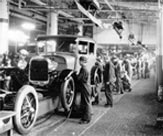Alan Mulally talks about Fighting for the Soul of Manufacturing Today
Capacity Utilization
Matching Ford’s Capacity to Consumer Demand
Ford’s ongoing success hinges on our ability to match our manufacturing capacity to consumer demand. That’s why we recently implemented a plan to better align the two – changing our entire approach to manufacturing in the process.
The better we are at using our manufacturing capacity, the more competitive we’ll be – and the better position we’ll be in to deliver profitable growth for all our stakeholders.
Adding capacity to our plants and making them more productive has enabled us to add jobs in the U.S. For example, we invested $400 million in the Chicago Assembly Plant and added a second shift to build the new Ford Explorer, bringing 1,200 new jobs to the facility. At the Louisville Assembly Plant, we’re investing $600 million to transform the plant to be able to build the next-generation Escape, adding a shift and with it, 1,800 jobs.
Matching capacity to demand can also mean making painful choices like our decision to close the Twin Cities Assembly Plant later this year. But sales of the Ranger – which Twin Cities builds – have been declining for years in the U.S., along with the entire compact pickup segment.
In addition to matching demand, our manufacturing system must be flexible. Going forward, we must be able to build multiple models at a single plant and respond quickly to gradual or abrupt shifts in consumer demand. When gas prices spiked in 2008, for example, demand swung away from trucks and SUVs to smaller, more fuel-efficient cars and crossovers. Today, we are better equipped to respond to preference shifts like this.
Instead, we have been going through a process in North America to transform our plants from those that solely built large trucks and SUVs to those that build smaller, more fuel-efficient vehicles. For example, we converted our Cuautitlan, Mexico facility from a large truck factory to one that today builds the global Fiesta for the North American market. After a significant transformation at the Michigan Assembly Plant, we are now building the Ford Focus for North America as opposed to large SUVs. At the same time, at the Michigan Assembly Plant, we have created the world’s first plant that will build gasoline-powered, battery electric, hybrid electric and plug-in hybrid electric vehicles – all on the same assembly line. And, we currently are renovating our Louisville Assembly Plant from a body-on-frame SUV facility to a factory capable of building the next-generation Ford Escape on Ford’s global compact car platform.
By having this flexibility, we are better able to respond to shifts in consumer preference in real time. This will help us to be a more flexible, responsive automaker over the longer term, which inevitably will lead to increased job security.












